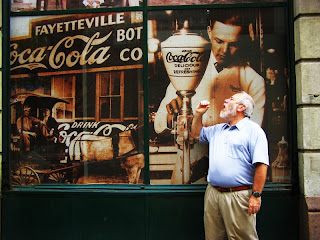Yesterday, our first day in Uruguay, we were walking in the Old Town (a historic district of Montevideo), a quiet and ordinary street with Saturday morning strollers.
Suddenly, a mugger came up behind Allen and tried to pick his pocket at the same moment that he shoved Allen to the ground. I was slightly ahead, getting ready to take a picture, so until I heard the commotion, I didn't realize what was happening. Poor Allen wound up on the ground, and this guy was sprinting up the hill. You would have laughed to see me running right behind him, screaming at him and cursing him and his mother in Spanish. Luckily, I didn't catch him. Allen called me back to him, and when I got him to stand up, I could see his left shoulder pulled sharply down.
Neither one of us mentioned the possibility of a broken shoulder. A mother sent her two small boys to take us to the nearby clinic, but the clinic wanted us to go to a trauma center. Allen stopped a member of the Tourist Police to ask for help. This guy swung into action, calling patrols and a backup car. Allen suddenly turned gray; I thought he was going to faint on the street. We were both worried about his shoulder being broken, and he was in considerable pain. The police took us to a unversity hospital where a doctor had his shoulder x-rayed immediately. Thank God, the shoulder was only dislocated, so the doctor popped it right back in, and the pain went away. The hospital didn't charge us anything, but sent us on our way with good wishes. We were then taken back to our hotel in the police car (several stares along the way) by the police with assurances that this happens rarely, with apologies, and with hopes we would enjoy the rest of our visit in Uruguay.
I don't think we could have done anything differently. We were in a tourist area. People everywhere helped us, despite our fractured Spanish and that we obviously were from another country. The Tourist Police of Uruguay were very helpful, courteous, and even funny. The woman officer reported our case to headquarters by saying in Spanish, "They haven't killed him, but . . . " So I'm left feeling it could have been much worse. I didn't like seeing my husband in pain, though he makes a joke out of it now and teases me for running after the
ladron. This could have happened anywhere and at any time.
So today, we are staying at home in our hotel, on the 5th floor above a lovely plaza filled with palm trees and maybe oaks. This rainy morning, we shared breakfast (coffee and croissants), with a soccer team. All is well.











